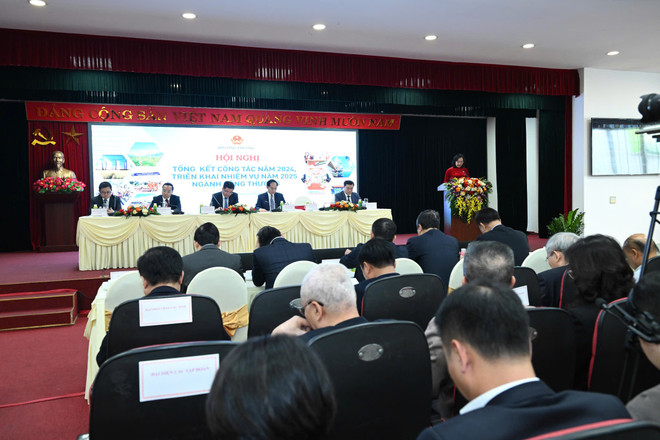Import and export activities have basically taken advantage of and effectively exploited market opening commitments from FTAs, and Vietnam's export growth with most markets that have signed FTAs has increased.
In export activities, businesses have actively taken advantage of opportunities from the recovery of large, traditional markets to boost exports, raising the total import-export turnover for the whole year of 2024 to a new record, expected to reach 783 billion USD (exceeding 100 billion USD compared to 2023).
The above information was given by the leaders of the Ministry of Industry and Trade at the "Conference to review the work in 2024 and deploy tasks in 2025 of the Industry and Trade sector," held on the afternoon of December 23, in Hanoi.
9 consecutive years of trade surplus
Reporting at the conference, Deputy Minister Phan Thi Thang said that in 2024, the estimated export turnover will reach 403 billion USD. The highlight is the high double-digit growth in export turnover with the positive recovery of key export groups, increasing by 13.6% compared to 2023 (decreased by 4.6% in 2023).
This is also a fairly high growth rate compared to many countries in the ASEAN region and Asia, in which, exports increased sharply in the agricultural, forestry and fishery products group (11-month increase of 20.6%), with favorable agricultural product prices supporting good consumption of output for agricultural production and people and the processed industrial products group (11-month increase of 14.3%).
According to statistics, the Asia-Africa market region continues to hold a strategic position with a total two-way import-export turnover estimated at 519.7 billion USD, an increase of 13.7% compared to 2023, accounting for 66.3% of Vietnam's total import-export turnover with the world (exports are estimated at 197.4 billion USD, an increase of 8.4%; imports are estimated at 322.3 billion USD, an increase of 17.2%; trade deficit is 124.9 billion USD, an increase of 34.6% compared to 2023).
In addition, the structure of export goods continues to improve in a positive direction, reducing the content of raw exports, increasing the export of processed products and industrial products, creating conditions for Vietnamese goods to participate more deeply in the global production and supply chain.
The processing industry group has recovered strongly, being the main driving force contributing to the country's total export turnover (accounting for nearly 85%). In particular, key export groups that faced many difficulties in 2023 have recovered quickly, regaining high growth momentum at double digits such as: Computers, electronic products and components reached 71.7 billion USD, up 25%; phones of all kinds and components reached 53.9 billion USD, up 2.9%; machinery, equipment, tools and other spare parts reached 52.6 billion USD, up 22%; textiles and garments reached 37 billion USD, up 11.2%; footwear of all kinds reached 22.9 billion USD, up 13%; wood and wood products reached 16.2 billion USD, up 20.3%; iron and steel reached 9.3 billion USD, up 11.8%...
According to the leader of the Ministry of Industry and Trade, international economic integration activities were implemented synchronously and effectively. Potential markets in the Middle East and Africa were opened up by signing an FTA with the UAE in a record negotiation time (16 months).
Import and export activities have basically taken advantage of and effectively exploited market opening commitments from FTAs, and Vietnam's export growth with most markets that have signed FTAs has increased.
For example, exports to the United States are estimated at 119.7 billion USD, accounting for 29.5% of total export turnover, up 23.4% compared to 2023 (down 11.3% in 2023); exports to the EU market are estimated at 51.6 billion USD, up 18.3% (down 6.8% in 2023); exports to the ASEAN market are estimated at 13.6%; exports to the Korean market are estimated at 25.5 billion USD, up 8.6% (down 3.4% in 2023); exports to the Japanese market are estimated at 24.6 billion USD, up 5.5% (down 3.7% in 2023).
Assessing the above results, according to Mr. Nguyen Minh Vu, Assistant Minister of Foreign Affairs, Vietnam has risen to 23rd place in the world and 2nd in ASEAN in terms of trade turnover, becoming the largest trade partner in ASEAN of the 3 leading economic centers: the United States, the EU and China, bringing important foreign currency sources for domestic financial resources and macroeconomics.
Especially with the Chinese market, the Ministry of Industry and Trade has removed difficulties, ensured the circulation of import and export goods, supply chains, successfully mobilized friends to open new markets for fresh coconuts, frozen durians... contributing to promoting trade turnover between the two countries to reach 200 billion USD.
In addition, international economic integration is increasingly deep, substantial and effective, contributing to raising the level of multilateral diplomacy, creating a widespread network of connections and continuing to promote new-generation FTAs.
“The Ministry of Industry and Trade also quickly caught up with the trend of green transformation and digital transformation, strengthening economic development drivers, contributing to promoting rapid and sustainable development,” he said.

In 2024, the export of agricultural products will also set a new record, exceeding 60 billion USD. To achieve the above results, according to Deputy Minister of Agriculture and Rural Development Vo Van Hung, the role of the Ministry of Industry and Trade as the One who brings the country's products to friends in 5 continents with new methods, new customers on all continents.
“Not only does it meet production needs, create conditions for products and product quality, but thanks to the Ministry of Industry and Trade as experts in many fields, it also helps to expand agricultural products,” said the Deputy Minister of Agriculture and Rural Development.
With the push from exports, the trade balance in 2024 continues to record a trade surplus for the 9th consecutive year (since 2016) with a fairly high surplus (estimated at 23 billion USD), contributing positively to the balance of payments, helping to increase foreign exchange reserves, stabilize exchange rates and other macroeconomic indicators of the economy.
Improve trade promotion effectiveness
Despite many outstanding results, the representative of the Ministry of Industry and Trade also pointed out many shortcomings, in which export activities, although recovering and growing rapidly, are not sustainable and are affected by many external factors. The majority of export turnover is brought by FDI enterprises (about 70%), but the exports of these enterprises depend heavily on the global supply chain and have not created a spillover effect, promoting domestic enterprises to participate in the global value chain.
Furthermore, export activities still depend on a number of large markets, mainly with Northeast Asian countries, the United States, ASEAN, and the EU (our country's export turnover to these four market regions accounts for nearly 80% of the country's total export turnover).
In addition, Vietnam's key export products to major markets such as the EU and the United States are facing pressures from trade defense investigations, origin fraud, technical barriers related to the environment, sustainable development, and green transformation.
The added value in exports has not been as expected, most of the exported goods are in the group of processed and manufactured goods and are mainly concentrated in FDI enterprises (such as textiles, footwear, electronics), the localization rate is low and depends heavily on imported raw materials, leading to low added value.
The level of trade liberalization and signing of FTAs tends to increase but is still limited in developing new export items and has not diversified export products. Many key industries such as agriculture, aquaculture, textiles, footwear, and electronics still account for a large proportion and have not developed high-tech products.
Therefore, in order to achieve the target of increasing goods exports by about 12% compared to 2024, the Ministry of Industry and Trade has proposed many solutions, including continuing to monitor and promptly provide information to industry associations and businesses about developments in the export market to promptly adjust production plans accordingly, especially changes in trade policies of major markets.
At the same time, the Ministry also regularly maintains trade promotion conferences with the Vietnamese Trade Office system abroad. Directs the Vietnamese Trade Office system abroad to regularly update information on the foreign market situation; regulations, standards, and conditions of foreign markets that may affect Vietnam's import and export activities and make recommendations to localities, associations, and import and export enterprises.

In addition, according to Minister Nguyen Hong Dien, to promote export activities, in the coming time, the Ministry will actively advise on negotiations, sign new and upgrade FTAs with potential partners, creating momentum to strengthen trade and investment cooperation; at the same time, increase support for businesses to strongly shift to official exports associated with brand building, promoting sustainable exports.
Along with that, focus on innovation, improve the effectiveness of trade promotion work, closely combine traditional trade with modern trade to effectively exploit the domestic market of 100 million people, which still has a lot of potential.
Appreciating the achievements of the Industry and Trade sector, Deputy Prime Minister Bui Thanh Son emphasized that in 2024, our country will achieve and exceed all 15/15 socio-economic development targets set by the National Assembly. GDP growth in 2024 is estimated at about 7%, among the few countries with high growth rates in the region and the world and is highly appreciated by international organizations.
“In the overall success of the whole country, there is a very important and comprehensive contribution of the Industry and Trade sector in both main tasks of perfecting institutions, policies, legal framework and improving the effectiveness and efficiency of state management, while at the same time creating and promoting production and business development," the Deputy Prime Minister emphasized.
According to the Deputy Prime Minister, striving for a growth rate of 8% or more in 2025 to create momentum, force, and position for the 2026-2030 period, achieving double-digit growth is a very high requirement, requiring great efforts from the entire political system, people, and businesses. In particular, the Industry and Trade sector needs to affirm its pioneering role in this process.
The Deputy Prime Minister raised a number of issues for the Industry and Trade sector to study and implement in the process of performing tasks in 2025 and the following years.
Accordingly, to liberate resources and attract investment, the first thing is to create a favorable, clear, transparent legal environment, remove barriers in administrative procedures for industrial production development and promote trade, in which it is necessary to continue to identify institutional and policy building as one of three strategic breakthroughs.
In addition, it is necessary to promptly review, complete and submit to the Prime Minister for promulgation the Strategy for Industrial Development, in order to enhance the independent and autonomous capacity of Vietnam's production sector. Develop high-tech, high-value-added and low-carbon emission industries, and issue strong enough incentive mechanisms to develop priority areas of key industries such as metallurgy; mechanical engineering; electronics and semiconductor industries; Develop an ecosystem of energy and supporting industries.
To do this, the Deputy Prime Minister said that, along with the efforts of the Ministry of Industry and Trade, close and effective coordination of ministries and branches is needed, especially the Ministry of Transport, Planning and Investment, Ministry of Science and Technology, Ministry of Information and Communications...
The Deputy Prime Minister noted that the Ministry of Industry and Trade should implement solutions to ensure national energy security. Avoiding power shortages is a mandatory requirement and a difficult problem in the context that in recent years, there have not been many new power source and grid projects implemented.
Strengthen trade promotion, diversify markets and supply chains; consolidate and expand market share in traditional markets; create breakthroughs in expanding new potential export markets; direct trade offices to closely coordinate with diplomatic agencies to effectively play the role of a bridge for businesses to "take root" in the market./.












